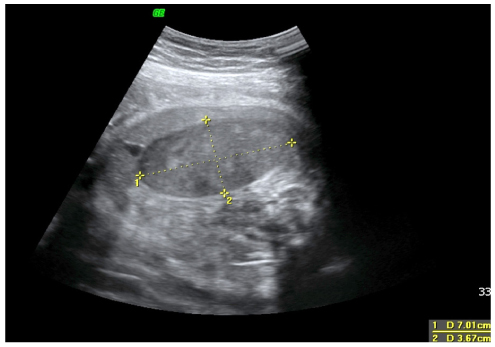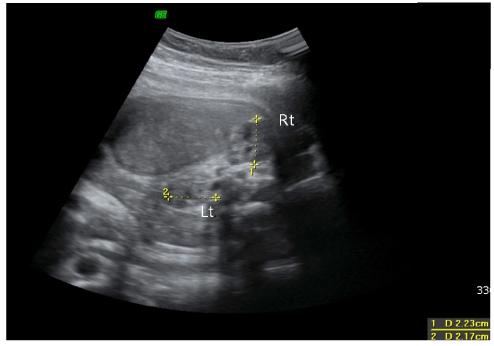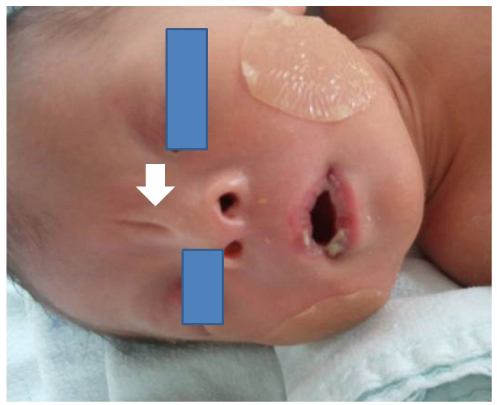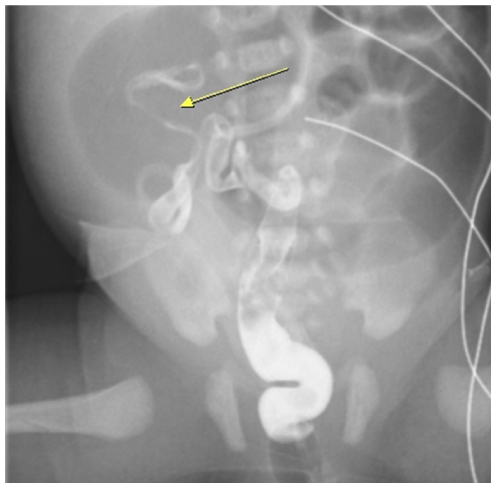Korean J Obstet Gynecol.
2012 Sep;55(9):655-658. 10.5468/KJOG.2012.55.9.655.
Colon atresia, a rare comorbid condition in VACTERL association
- Affiliations
-
- 1Department of Obstetrics and Gynecology, Kyungbook National University School of Medicine, Deagu, Korea. wjseong@knu.ac.kr
- KMID: 2274138
- DOI: http://doi.org/10.5468/KJOG.2012.55.9.655
Abstract
- Vertebral, anal, cardiac, tracheoesophageal, renal and limb (VACTERL) association is defined by the presence of at least three of the following six congenital malformations: vertebral defects, anal atresia, cardiac defects, tracheo-esophageal fistula, renal anomalies and limb abnormalities. The abdominal cystic mass, suspicious of colon atresia was identified on prenatal ultrasonography. The new born infant exhibited single umbilical artery, hemivertebra, hypoplastic nasal bone, ventricular septal defect, patent ductus arteriosus, colon atresia. For treatment of colon atresia, two staged surgery was provided by a pediatric surgeon. We experienced colon atresia, a very rare comorbid condition in VACTERL association. Prompt diagnosis and surgical correction was possible with the cooperation of pediatric surgeons, obstetricians and pediatricians.
MeSH Terms
-
Anal Canal
Anus, Imperforate
Colon
Ductus Arteriosus, Patent
Esophagus
Extremities
Fistula
Heart Defects, Congenital
Heart Septal Defects, Ventricular
Humans
Infant
Kidney
Limb Deformities, Congenital
Nasal Bone
Single Umbilical Artery
Spine
Trachea
Ultrasonography, Prenatal
Anal Canal
Esophagus
Heart Defects, Congenital
Kidney
Limb Deformities, Congenital
Spine
Trachea
Figure
Reference
-
1. Botto LD, Khoury MJ, Mastroiacovo P, Castilla EE, Moore CA, Skjaerven R, et al. The spectrum of congenital anomalies of the VATER association: an international study. Am J Med Genet. 1997. 71:8–15.2. Källén K, Mastroiacovo P, Castilla EE, Robert E, Källén B. VATER non-random association of congenital malformations: study based on data from four malformation registers. Am J Med Genet. 2001. 101:26–32.3. Evans JA, Vitez M, Czeizel A. Patterns of acrorenal malformation associations. Am J Med Genet. 1992. 44:413–419.4. Khoury MJ, Cordero JF, Greenberg F, James LM, Erickson JD. A population study of the VACTERL association: evidence for its etiologic heterogeneity. Pediatrics. 1983. 71:815–820.5. Czeizel A, Ludányi I. An aetiological study of the VACTERL-association. Eur J Pediatr. 1985. 144:331–337.6. Damian MS, Seibel P, Schachenmayr W, Reichmann H, Dorndorf W. VACTERL with the mitochondrial np 3243 point mutation. Am J Med Genet. 1996. 62:398–403.7. de Jong EM, Douben H, Eussen BH, Felix JF, Wessels MW, Poddighe PJ, et al. 5q11.2 deletion in a patient with tracheal agenesis. Eur J Hum Genet. 2010. 18:1265–1268.8. Solomon BD. VACTERL/VATER Association. Orphanet J Rare Dis. 2011. 6:56.9. Oral A, Caner I, Yigiter M, Kantarci M, Olgun H, Ceviz N, et al. Clinical characteristics of neonates with VACTERL association. Pediatr Int. 2012. 54:361–364.10. Mittal A, Airon RK, Magu S, Rattan KN, Ratan SK. Associated anomalies with anorectal malformation (ARM). Indian J Pediatr. 2004. 71:509–514.11. Evans CH. Atresias of the gastrointestinal tract. Int Abstr Surg. 1951. 92:1–8.12. Franken EA, Smith WL. Gastrointestinal imaging in pediatrics. 1982. 2nd ed. New York: Harper & Row.13. Boles ET Jr, Vassy LE, Ralston M. Atresia of the colon. J Pediatr Surg. 1976. 11:69–75.
- Full Text Links
- Actions
-
Cited
- CITED
-
- Close
- Share
- Similar articles
-
- The VACTERL Association: Tracheal Stenosis, Tracheal Bronchus and Partial Pulmonary Agenesis, Instead of Tracheoesophageal Fistula
- A case of Down syndrome associated with colonic atresia
- VACTERL Association with Meningomyelocele Combined with Trisomy 18 Syndrome
- Esophageal Atresia without Tracheoesophageal Fistula: Report of 6 Cases
- A Case of Congenital Colonic Atresia Associated with Imperforate Anus






